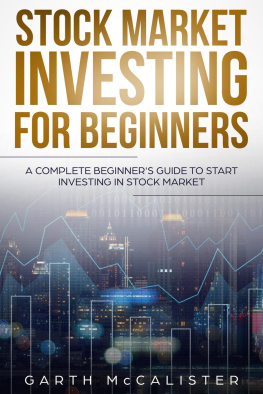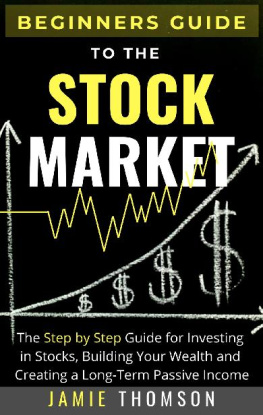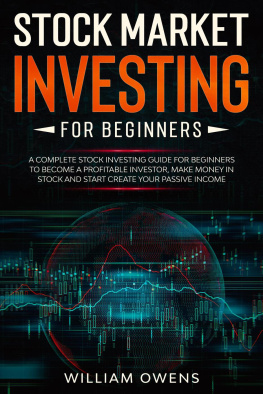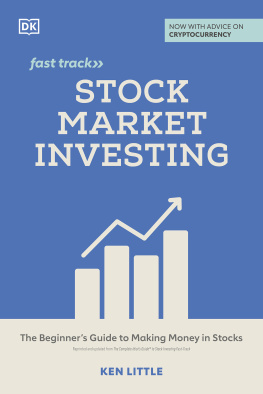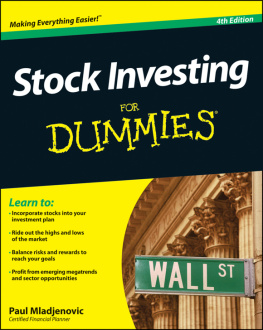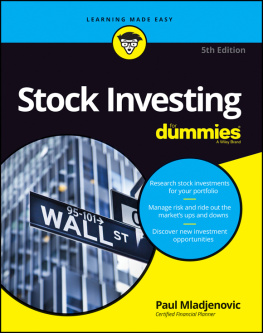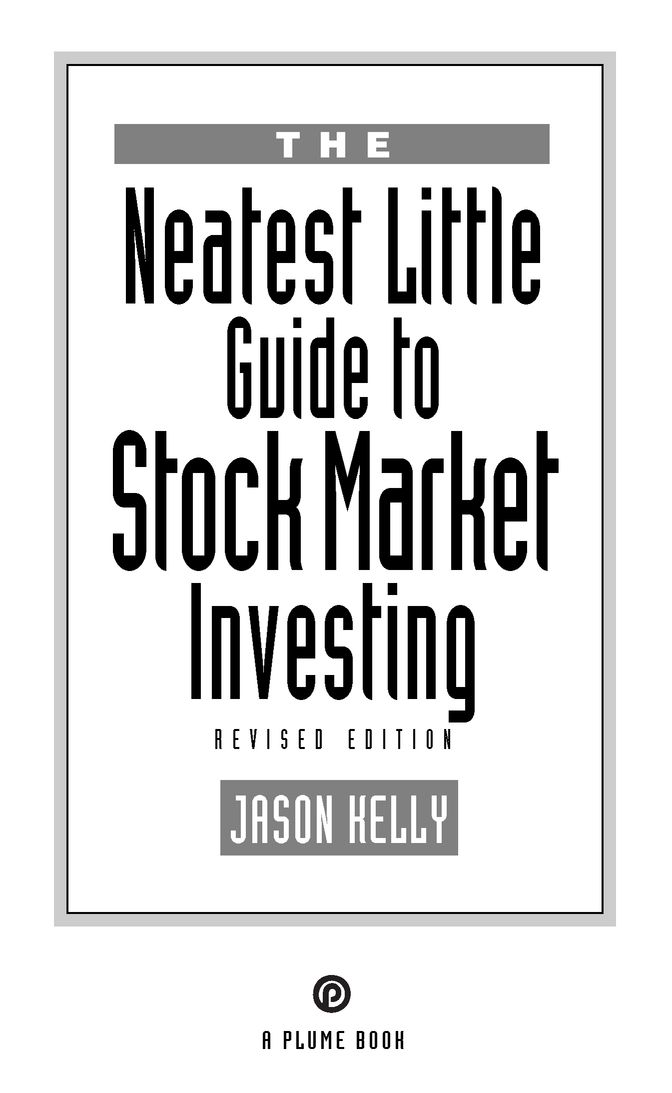Table of Contents
A PLUME BOOK
THE NEATEST LITTLE GUIDE TO STOCK MARKET INVESTING
JASON KELLY graduated in 1993 from the University of Colorado at Boulder with a bachelor of arts in English. He worked for several years at IBMs Silicon Valley Laboratory, where he wrote articles and books that won him the Society for Technical Communications Merit Award. He moved from writing about computers to writing about finance, and found his niche in the stock market. Having realized his dream of being able to live and work anywhere in the world, Jason moved to Japan in 2002 and works from his office in the countryside about two hours from Tokyo. He keeps busy writing new books, editing The Kelly Letter, maintaining online businesses, and exploring little-known parts of Japan. Visit his website at www.jasonkelly.com.
The Neatest Little Guide stands alone. There is no other book on the market like this one.
Michael H. Sherman, chairman,
Sierra Global Management LLC,
on The Neatest Little Guide to Mutual Fund Investing
Ten Steps to Investing in Stocks
1. Learn Why Stocks Are Good Investments
2. Learn How to Evaluate Stocks
3. Learn How the Masters Tell Us to Invest
4. See How History Tells Us to Invest
5. See How to Beat the Dow with Leverage
6. See How Leveraging Medium-Sized Companies Works Even Better
7. Choose a Broker
8. Research Your Stocks
9. Buy Your Stocks
10. Sell Your Stocks
Acknowledgments
Im fortunate to work with a wonderful team of people.
Doris Michaels remains the only agent Ive ever had, and its a joy to still work with her after all these years.
Im not the only one who took a liking to Doris. Charlie Michaels met her first and married her. He is president of Sierra Global Management, LLC, a hedge fund company in New York City. Charlies thorough understanding of the stock market helped with the first edition of this book, and his comments have provided the last word in each subsequent edition.
This book is packed full of content from many fine people and organizations. Thanks to Bill Miller, one of the best mutual fund managers in the business who took time to review the material I wrote about him and to answer questions from subscribers to The Kelly Letter. Thanks to Morningstar, Standard & Poors, Value Line, and Yahoo! Finance for supplying me with all the data I requested, and to OnlineTradingConcepts.com and StockCharts.com for supplying the charts I requested.
Finally, a nod of gratitude to the swell folks at Plume. My editor, Nadia Kashper, has been with this book for years, first as its editors assistant and now as its editor. Shes always a pleasure.
Foreword: This Book Always Works
The advice in this book works. It keeps you out of dangerous stocks and shows you how to find good stocks that make money over time.
I wrote the first edition in 1996 and 1997, just before the market began its steep ascent into the bubble of the century. Back then, Enron and WorldCom were talked about as must-own companies and the Internet was expected to put so-called old economy companies like Wal-Mart out of business. Who would walk the aisles of a store when they could shop online in their pajamas?
Plenty of us, evidently. In the years following this books first publication to early 2009, Wal-Mart stock nearly doubled while most Internet start-ups disappeared and Enron and WorldCom declared bankruptcy. In early 2008, Wal-Marts annual sales were $405 billion. The two leading Internet merchants at that time, Amazon.com and eBay, had annual sales of only $19 billion and $9 billion, respectively.
The subprime crash of 2008 destroyed famous companies like AIG (-97 percent), Bear Stearns (-100 percent), Lehman Brothers (-100 percent), and General Motors (-100 percent). Wal-Mart stock, however, gained 20 percent in 2008. It increased sales and cash flow per share in every one of the previous ten years, and did so again in 2008. Had you invested $10,000 in Wal-Mart in 1974, it would have been worth $29.5 million at the end of 2008, thanks to the companys steady growth and nine 2-for- 1 stock splits.
This book would have kept you out of Enron, WorldCom, the dot.com disasters, and the likes of Lehman Brothers. It would not have kept you out of the markets volatility, and no approach to stocks will. The market is volatile in the short term and rises over the long term.
On that path, you want companies like Wal-Mart working for your money. This book shows you how to find them. Its methods win in flat markets, rising markets, and falling markets because superior companies always come out on top.
Invest in them and youll come out on top, too.
I also present a value averaging technique that produces steady 3 percent quarterly growth, and bold index strategies for beating the market over time. The Dow dividend strategies and my doubling strategies for the Dow and S&P MidCap 400 offer excellent profit potential. When combined with methods to limit market weakness, they work wonders on your wealth.
This book is packed with advice that you can use right away. Read it, follow it, and watch your net worth grow.
Speak the Language of Stocks
Anybody can make money in the stock market. By picking up the phone or turning on the computer, you can own a piece of a companyand all of its fortune or follywithout ever attending a board meeting, developing a product, or devising a marketing strategy. When I was eleven years old, my grandfather explained to me in less than ten seconds why he invested in stocks. We sat by his pool in Arcadia, California, and he read the stock tables. I asked why he looked at all that fine print on such a beautiful day. He said, Because it takes only $10,000 and two tenbaggers to become a millionaire. That didnt mean much to me at the time, but it does now. A tenbagger is a stock that grows tenfold. Invest $10,000 in your first tenbagger and you have $100,000. Invest that $100,000 in your second tenbagger and you have $1 million. That, in less than ten seconds, is why everybody should invest in stocks.
This chapter further explains why investing in stocks is a good idea, then covers some basic information youll use in the rest of the book when you begin investing.
Why Stocks Are Good Investments
You should know why stocks are good investments before you start investing in them. There are two reasons to own stocks. First, because they allow you to own successful companies and, second, because theyve been the best investments over time.
Stocks Allow You to Own Successful Companies
Stocks are good investments because they allow you to own successful companies. Just like you can have equity in your home, you can have equity in a company by owning its stock. Thats why stocks are sometimes called equities.
Think of all the rich people youve read about. How did they get rich? Was it by lending money to relatives who never repay? No. Was it by winning the lottery? Not very often. Was it by inheriting money? In some cases, but its irrelevant because nobody has control over this factor. In most cases, rich people got rich by owning something.




